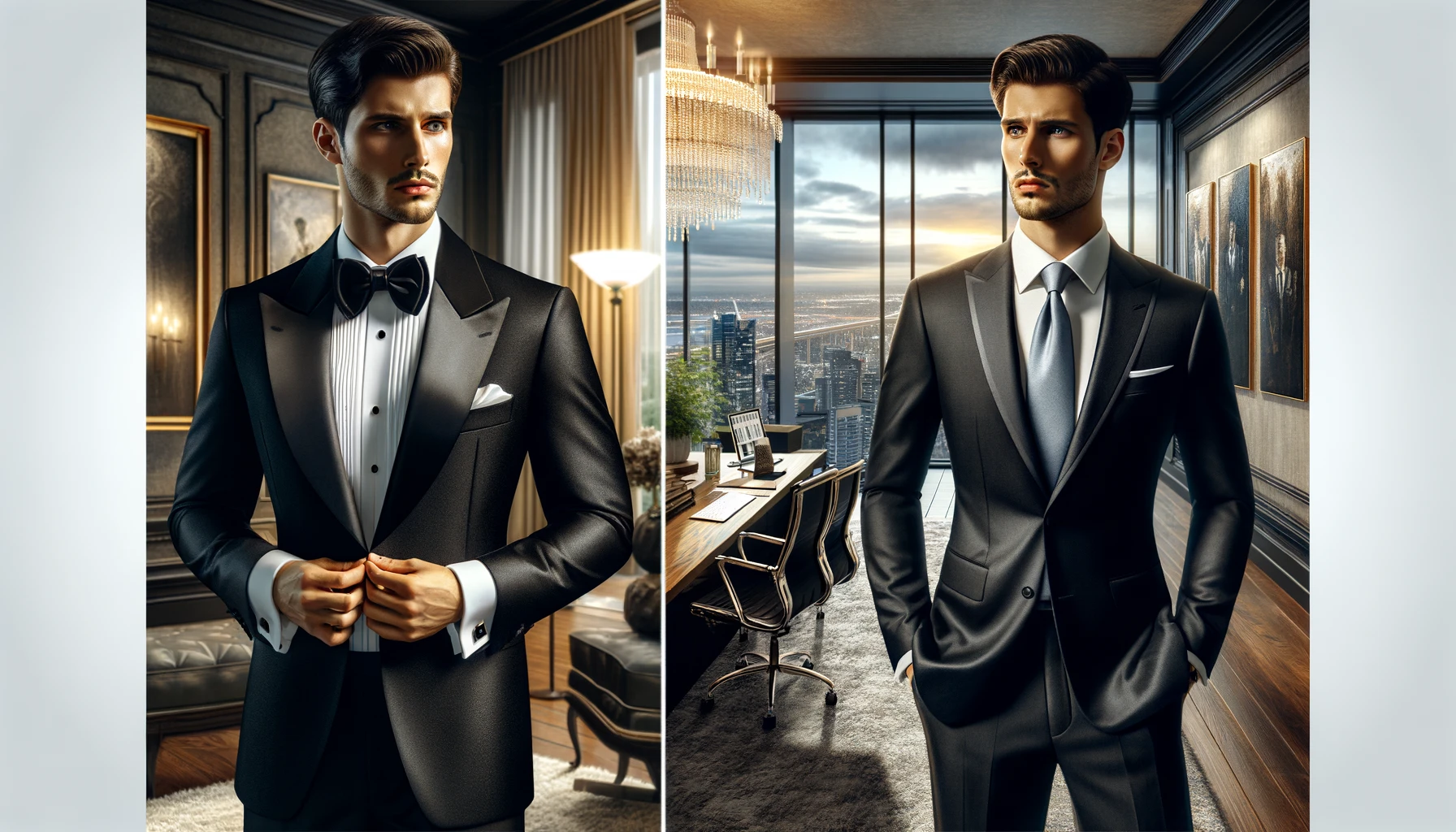They may look like close cousins at first glance, but the dinner suit and the business suit occupy distinct territories in the realm of men’s formal wear. Understanding Dinner Suit vs Business Suit is not that much difficult. The differences between these two garments can ensure you arrive at any event impeccably dressed and confident.
A Tale of Two Suits: Origins and Evolution
The history of the business suit stretches back centuries. Its roots lie in practical attire worn by European nobility for hunting and riding. By the 19th century, the suit had transformed into a symbol of professionalism and social status. The classic two-piece suit, with its tailored jacket and trousers, became the go-to outfit for businessmen and gentlemen attending formal daytime events.
The dinner suit, also known as a tuxedo in the United States, has a more recent origin story. Edward VII of England is credited with commissioning the first dinner jacket in the late 19th century. This short, black jacket with satin lapels was designed for a more relaxed, yet still formal, evening attire. The term “tuxedo” is believed to be derived from the Tuxedo Park Club in New York, where the garment gained popularity amongst wealthy socialites in the early 20th century.
Dinner Suit Vs Business Suit: Key Distinctions
While both dinner suits and business suits project a sense of sophistication, several key features set them apart:
- Fabric and Color: Business suits come in a wider variety of fabrics like wool, cotton blends, and linen. Colors range from classic navy and charcoal to more adventurous patterns like pinstripes and checks. Dinner suits, on the other hand, traditionally adhere to a black or midnight blue color palette, crafted from luxurious fabrics like wool or silk.
- Lapels and Buttons: Business suits typically have notch lapels, which blend seamlessly into the jacket. Dinner suits boast satin lapels, adding a touch of elegance and formality. Business suit buttons are usually made from the same material as the jacket, while dinner suits often feature sleek, black buttons made from plastic or other materials.
- Trousers and Details: Business suit trousers have belt loops to accommodate a leather belt. Dinner suit trousers, however, lack belt loops and instead utilize a hidden adjustable waistband with side adjusters for a clean and streamlined look. Additionally, dinner suit trousers often feature a distinctive satin stripe running down the outer seam, further distinguishing them from their business counterparts.
- Accessories: The classic business suit is complemented by a long tie, typically in a solid color or a subtle pattern that complements the shirt. Dress shoes like oxfords or derbys complete the professional look. Dinner suits, on the other hand, demand a black bow tie and a cummerbund or waistcoat for a more formal touch. Dress shoes should be sleek and polished, like patent leather or calfskin.
Here is a table for dinner suit vs business suit for better understanding.
| Feature | Dinner Suit | Business Suit |
| Fabric | Black or Midnight Blue (Luxury) | Variety (Wool, Cotton Blends, Linen) |
| Lapels | Satin | Notch |
| Buttons | Black (Plastic/Other) | Same as jacket material |
| Trousers | No belt loops, satin stripe | Belt loops |
| Accessories | Bow tie, cummerbund/waistcoat, patent leather/calfskin shoes | Long tie, dress shoes (oxfords/derbys) |
| Occasions | Black-tie events, galas, award ceremonies, evening weddings | Work meetings, conferences, formal dinners, daytime weddings |
Choosing Your Suit: When to Wear What
Knowing which suit to wear boils down to the occasion’s level of formality.
- Business Suits: Business suits are ideal for work meetings, conferences, formal dinners, and daytime weddings or semi-formal events. Their versatility allows for a variety of combinations depending on the occasion’s formality.
- Dinner Suits: Dinner suits are reserved for black-tie events, galas, award ceremonies, and evening weddings. They exude sophistication and elegance, making them the perfect choice for occasions demanding a heightened level of formality.
Read More: Birmingham Business Journal: Key to City’s Growth
Beyond the Basics: Tuxedo Variations and Business Suit Finesse
While the classic dinner suit reigns supreme, there’s room for a touch of personal style:
- Midnight Blue Tuxedo: A slightly less formal option for black-tie events, the midnight blue tuxedo offers a touch of modern flair while maintaining its elegance.
- Shawl Lapel Tuxedo: This tuxedo features a continuous curved lapel that adds a touch of sophistication and is often seen at more formal events.
For business suits, exploring different fabrics, patterns, and color combinations can add personality without compromising professionalism:
- Bold Colors and Patterns: For a more fashion-forward approach, consider a business suit in a rich burgundy or a subtle pinstripe pattern. Ensure the colors and patterns complement your skin tone and the overall style of the event.
- Pocket Squares and Ties: A well-chosen pocket square or a patterned tie can elevate your business suit, adding a pop of color or a touch of personal flair.
FAQs
1. Can I wear a business suit to a black-tie event?
No, a business suit is not appropriate for a black-tie event. The key difference lies in formality. While a business suit exudes professionalism, a dinner suit (tuxedo) is specifically designed for more formal evening occasions.
2. Is there a difference between a tuxedo and a dinner suit?
In essence, no. Tuxedo is basically a term used in America for a dinner suit. Both terms refer to the same formal evening attire.
3. Can a dinner suit be any color?
Traditionally, dinner suits are black or midnight blue. However, very formal events may see a peak lapel tuxedo in a deep charcoal or even a midnight green. It’s best to stick to classic black or blue unless the event invitation explicitly allows for a bit of color variation.
4. Can I wear a regular tie with a dinner suit?
Absolutely not. Dinner suits demand a black bow tie for a formal and sophisticated look. A regular tie would clash with the elegance of the tuxedo.
5. Are there different styles of business suits?
Yes, business suits come in a wider variety of styles compared to dinner suits. You can choose from classic fit, slim fit, modern fit, single-breasted or double-breasted jackets, and a broader range of colors and patterns.
6. Can I wear a pocket square with a dinner suit?
Yes, a pocket square can add a touch of personality to your dinner suit ensemble. Opt for a simple, folded pocket square in a complementary color to the bow tie or cummerbund.
Final Thought
Understanding the nuances between dinner suits and business suits empowers you to make informed decisions about your attire. By choosing the right suit and complementing it with appropriate accessories, you can project confidence and sophistication at any event, be it a high-powered business meeting or a glamorous gala. Remember, a well-tailored suit, worn with care, speaks volumes about your style and attention to detail. So, the next time you have a formal occasion.




